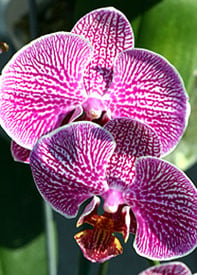
Flowers use all sorts of tricks to attract the insects that pollinate them. Some orchid species entice insect pollinators with sweet, fragrant scents. Others emit no odor but tempt insects with using color or shape. A few flower species emit repulsive odors, such as rotting meat or decaying organic matter, to lure pollinating insects that feed on carrion. Recently, researchers discovered an orchid that mimics the smell of its pollinator’s prey to attract pollinating insects.
The Scarce Marsh Hellebornine, a terrestrial orchid formally known as Epipactis veratrifolia, generates the odor of frightened aphids to lure hoverflies to land on its pollen-coated stamen. When alarmed, aphids release pheromones known as kairomones. Hoverflies use that unique odor to track their prey. Avid aphid eaters, hoverflies can’t resist the scent of a good meal and land on the orchid expecting to chow down. The discovery of this orchid’s unique attraction method was made by researchers from the German Universities of Regensburg and Ulm and published in the Proceedings of the Royal Society B. Researches noted that this is the first known demonstration of orchid scent mimicry.
In orchids and other flowering plants, pollination is the age-old dance of reproduction that ensures species survival. Both flower and pollinator benefit from their relationship. When hoverflies scurry over Scarce Marsh Hellebornine orchids in search of phantom aphids, they not only pollinate the plant, females lay their eggs within the orchid’s folds. It’s a win-win scenario.
A similar relationship has evolved between Phalaenopsis orchids and the orchid bee, the plant’s main pollinator. To promote pollination, Phalaenopsis orchids use color to attract orchid bees. These insects have developed an unusually long proboscis that allows them to reach the deep centers of the orchid flower. To accommodate their pollinators, Phalaenopsis orchids have developed a lip that provides a place for bees to rest while depositing and gathering pollen. Again, both species win.

Copyright Just Add Ice® Orchids 2023